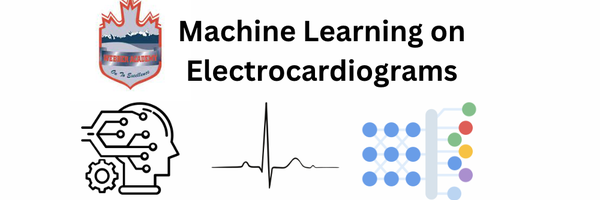Use of Convolutional Neural Networks in electrocardiogram readings to identify heart diseases and predict heart attacks
Grade 11
Presentation
Problem
Currently, heart disease is the leading cause of death in the United States of America, with a heart attack occuring every 40 seconds. In Canada, this problem is also prevalent with 14 deaths attributed to heart disease every hour.
Method
Data Preprocessing:
- Take the electrocardiogram patient data and convert to Spectogram / frequency domain
Convolutional Neural Network
- Define the architechture (Input --> Convolutional --> Pooling --> Convolutional --> Pooling --> fully connected --> fully connected --> classification
Validation / Training
- five fold cross validation
- Accruacy is the average of all of those values
Analysis
The machine learning model was able to achieve a training accuracy of 95% and a validation accuracy of 83%.
I also analysed the behaviour of the machine learning model at various different learning rates.
|
Learning Rate |
Training Accuracy |
Validation Accuracy |
|
1 * 10^-3 |
82% |
76% |
|
1 * 10^-4 |
95% |
83% |
|
1 * 10^-5 |
78% |
80% |
Conclusion
Although my model was not able to perform to the same accuracy as other convolutional neural networks using time frequency analysis, it was able to achieve an accuracy of 83% with limited data. However, my model was able to succeed in obtaining an accuracy similar / replicate what a physician is able to achieve in ECG reeadings. This is because my model accuracy was roughly 80% and the range of physician accuracy ranges from 49 - 92 percent.
Citations
(these are the sources referenced in my poster however I had many more sources for background research)
[1] “Heart disease facts,” Centers for Disease Control and Prevention, Heart Disease Facts | cdc.gov. (accessed Mar. 1, 2024).
[2] P. H. A. of Canada, “Government of Canada,” Canada.ca, Heart Disease in Canada (accessed Mar. 1, 2024).
[3] Wu, Ziqian, Tianjie Lan, Cuiwei Yang, and Zhenning Nie. 2019. “A Novel Method to Detect Multiple Arrhythmias Based on Time-Frequency Analysis and Convolutional Neural Networks.” IEEE Access: Practical Innovations, Open Solutions 7: 170820–30 (accessed Mar. 1, 2024).
[4] “ECG (electrocardiogram),” Cancer Research UK, https://www.cancerresearchuk.org/about-cancer/tests-and-scans/ecg#:~:text=You%20might%20get%20your%20results,your%20doctor%20needs%20the%20results (accessed Mar. 1, 2024).
Acknowledgement
I would like to acknowledge my applied science teacher, Dr. Garcia and my applied science mentor, Dr. Pieper.

